Health Record System: Requirements, Use Cases, and Stakeholder Report
VerifiedAdded on 2021/06/14
|8
|1949
|88
Report
AI Summary
This report presents an analysis of a health record system designed to improve mental healthcare for young people. It begins with a stakeholder map, categorizing stakeholders based on power/influence and interest, including external and internal executive and operational stakeholders. The report then details the use of questionnaires to gather requirements from headspace workers, including questions about their current practices and needs for an integrated system. A sample questionnaire is provided. A use case diagram illustrates the interactions between actors and the system, with use cases such as managing patients, recording patient stories, and sending patients to doctors. Detailed use case descriptions are provided, outlining the steps involved in recording patient history. The report concludes with references to relevant sources.

COVER PAGE
Paraphrase This Document
Need a fresh take? Get an instant paraphrase of this document with our AI Paraphraser
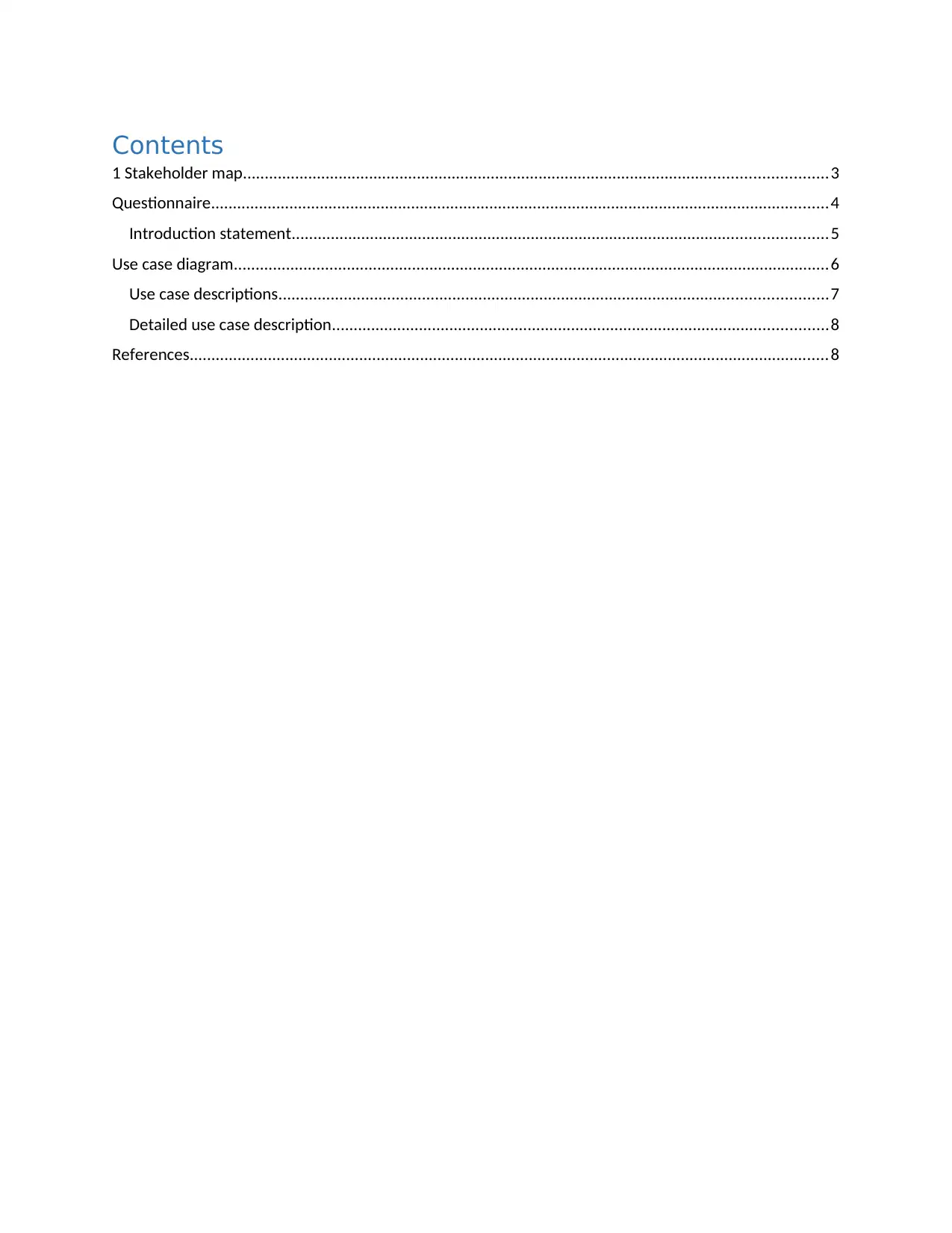
Contents
1 Stakeholder map......................................................................................................................................3
Questionnaire..............................................................................................................................................4
Introduction statement...........................................................................................................................5
Use case diagram.........................................................................................................................................6
Use case descriptions..............................................................................................................................7
Detailed use case description..................................................................................................................8
References...................................................................................................................................................8
1 Stakeholder map......................................................................................................................................3
Questionnaire..............................................................................................................................................4
Introduction statement...........................................................................................................................5
Use case diagram.........................................................................................................................................6
Use case descriptions..............................................................................................................................7
Detailed use case description..................................................................................................................8
References...................................................................................................................................................8
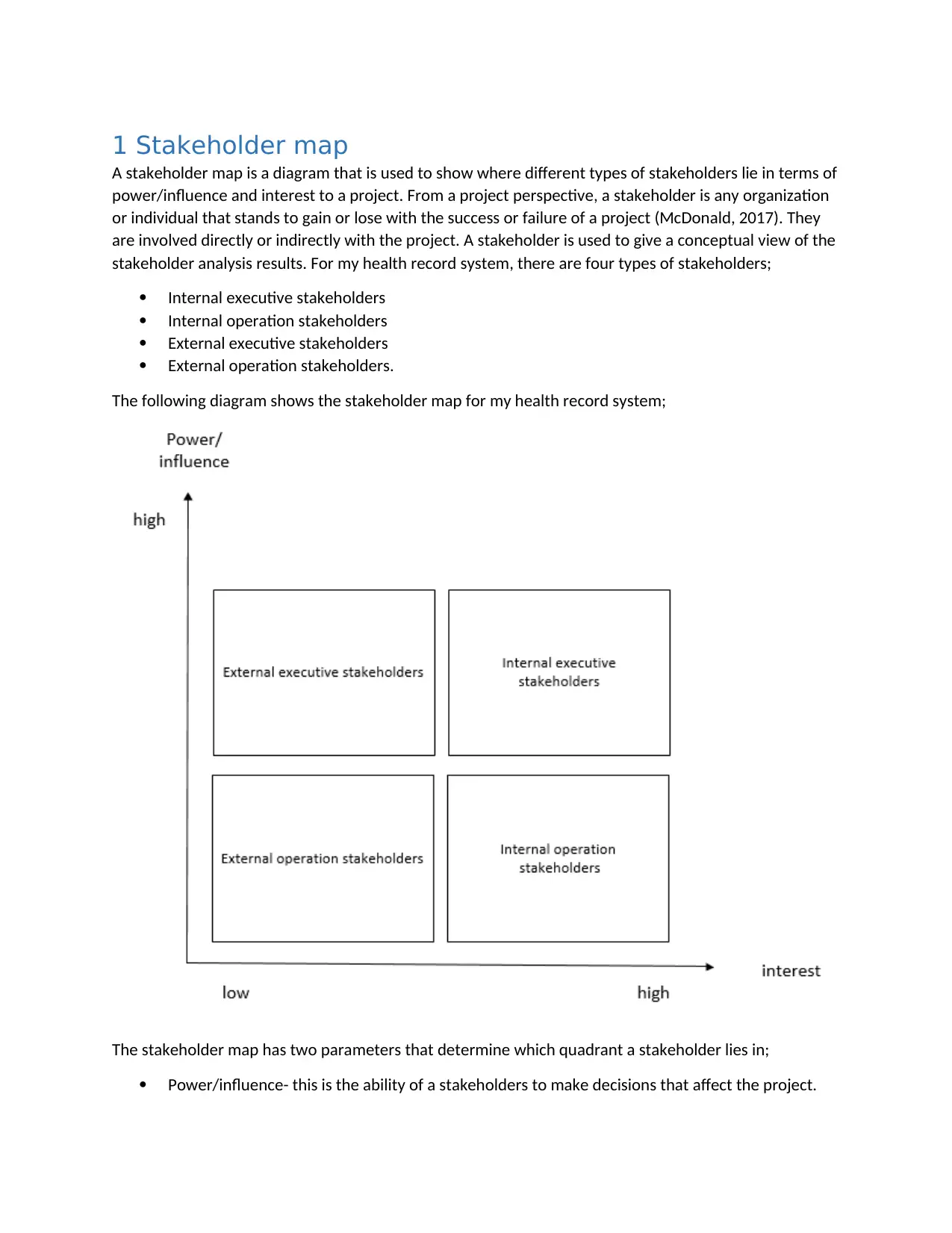
1 Stakeholder map
A stakeholder map is a diagram that is used to show where different types of stakeholders lie in terms of
power/influence and interest to a project. From a project perspective, a stakeholder is any organization
or individual that stands to gain or lose with the success or failure of a project (McDonald, 2017). They
are involved directly or indirectly with the project. A stakeholder is used to give a conceptual view of the
stakeholder analysis results. For my health record system, there are four types of stakeholders;
Internal executive stakeholders
Internal operation stakeholders
External executive stakeholders
External operation stakeholders.
The following diagram shows the stakeholder map for my health record system;
The stakeholder map has two parameters that determine which quadrant a stakeholder lies in;
Power/influence- this is the ability of a stakeholders to make decisions that affect the project.
A stakeholder map is a diagram that is used to show where different types of stakeholders lie in terms of
power/influence and interest to a project. From a project perspective, a stakeholder is any organization
or individual that stands to gain or lose with the success or failure of a project (McDonald, 2017). They
are involved directly or indirectly with the project. A stakeholder is used to give a conceptual view of the
stakeholder analysis results. For my health record system, there are four types of stakeholders;
Internal executive stakeholders
Internal operation stakeholders
External executive stakeholders
External operation stakeholders.
The following diagram shows the stakeholder map for my health record system;
The stakeholder map has two parameters that determine which quadrant a stakeholder lies in;
Power/influence- this is the ability of a stakeholders to make decisions that affect the project.
⊘ This is a preview!⊘
Do you want full access?
Subscribe today to unlock all pages.

Trusted by 1+ million students worldwide
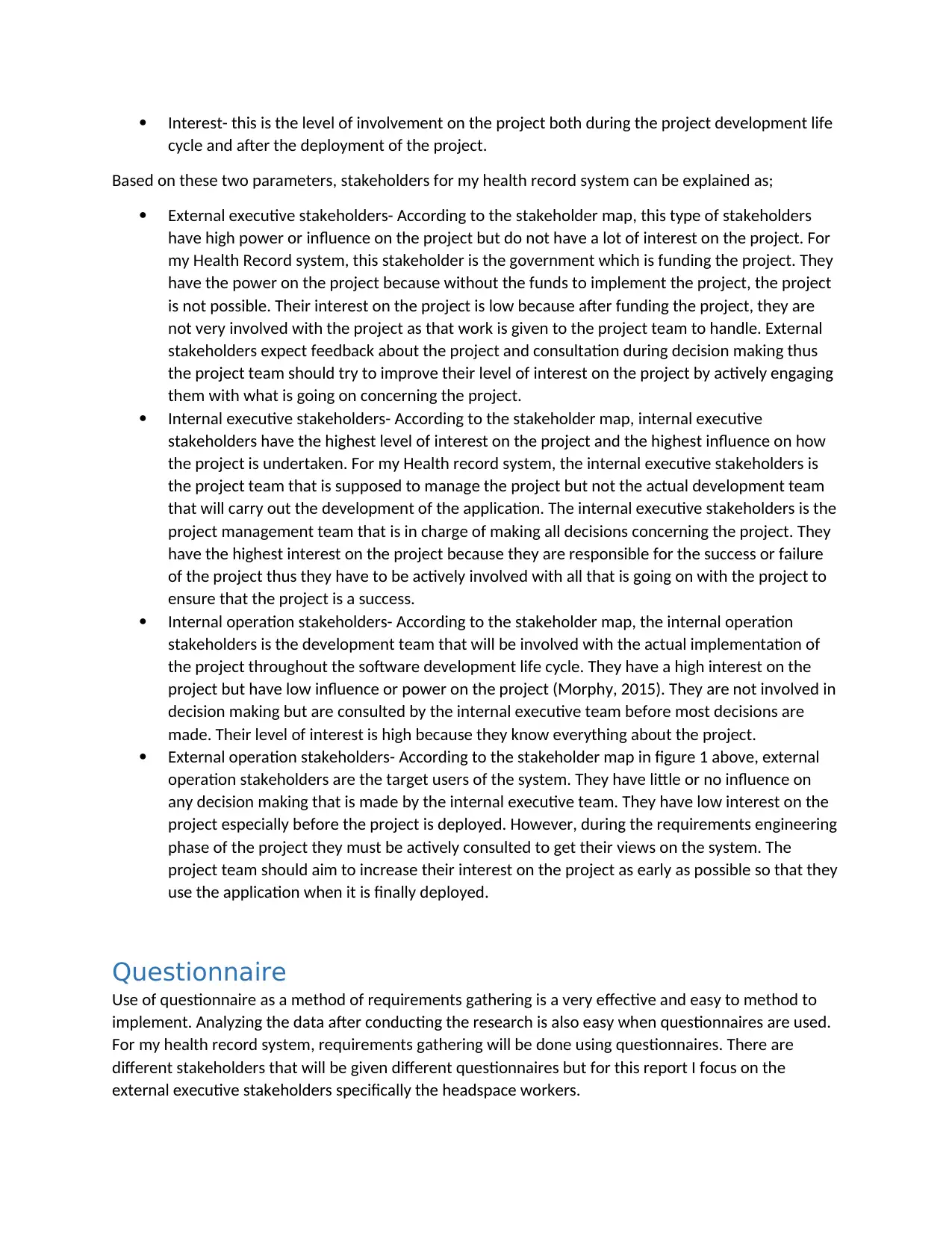
Interest- this is the level of involvement on the project both during the project development life
cycle and after the deployment of the project.
Based on these two parameters, stakeholders for my health record system can be explained as;
External executive stakeholders- According to the stakeholder map, this type of stakeholders
have high power or influence on the project but do not have a lot of interest on the project. For
my Health Record system, this stakeholder is the government which is funding the project. They
have the power on the project because without the funds to implement the project, the project
is not possible. Their interest on the project is low because after funding the project, they are
not very involved with the project as that work is given to the project team to handle. External
stakeholders expect feedback about the project and consultation during decision making thus
the project team should try to improve their level of interest on the project by actively engaging
them with what is going on concerning the project.
Internal executive stakeholders- According to the stakeholder map, internal executive
stakeholders have the highest level of interest on the project and the highest influence on how
the project is undertaken. For my Health record system, the internal executive stakeholders is
the project team that is supposed to manage the project but not the actual development team
that will carry out the development of the application. The internal executive stakeholders is the
project management team that is in charge of making all decisions concerning the project. They
have the highest interest on the project because they are responsible for the success or failure
of the project thus they have to be actively involved with all that is going on with the project to
ensure that the project is a success.
Internal operation stakeholders- According to the stakeholder map, the internal operation
stakeholders is the development team that will be involved with the actual implementation of
the project throughout the software development life cycle. They have a high interest on the
project but have low influence or power on the project (Morphy, 2015). They are not involved in
decision making but are consulted by the internal executive team before most decisions are
made. Their level of interest is high because they know everything about the project.
External operation stakeholders- According to the stakeholder map in figure 1 above, external
operation stakeholders are the target users of the system. They have little or no influence on
any decision making that is made by the internal executive team. They have low interest on the
project especially before the project is deployed. However, during the requirements engineering
phase of the project they must be actively consulted to get their views on the system. The
project team should aim to increase their interest on the project as early as possible so that they
use the application when it is finally deployed.
Questionnaire
Use of questionnaire as a method of requirements gathering is a very effective and easy to method to
implement. Analyzing the data after conducting the research is also easy when questionnaires are used.
For my health record system, requirements gathering will be done using questionnaires. There are
different stakeholders that will be given different questionnaires but for this report I focus on the
external executive stakeholders specifically the headspace workers.
cycle and after the deployment of the project.
Based on these two parameters, stakeholders for my health record system can be explained as;
External executive stakeholders- According to the stakeholder map, this type of stakeholders
have high power or influence on the project but do not have a lot of interest on the project. For
my Health Record system, this stakeholder is the government which is funding the project. They
have the power on the project because without the funds to implement the project, the project
is not possible. Their interest on the project is low because after funding the project, they are
not very involved with the project as that work is given to the project team to handle. External
stakeholders expect feedback about the project and consultation during decision making thus
the project team should try to improve their level of interest on the project by actively engaging
them with what is going on concerning the project.
Internal executive stakeholders- According to the stakeholder map, internal executive
stakeholders have the highest level of interest on the project and the highest influence on how
the project is undertaken. For my Health record system, the internal executive stakeholders is
the project team that is supposed to manage the project but not the actual development team
that will carry out the development of the application. The internal executive stakeholders is the
project management team that is in charge of making all decisions concerning the project. They
have the highest interest on the project because they are responsible for the success or failure
of the project thus they have to be actively involved with all that is going on with the project to
ensure that the project is a success.
Internal operation stakeholders- According to the stakeholder map, the internal operation
stakeholders is the development team that will be involved with the actual implementation of
the project throughout the software development life cycle. They have a high interest on the
project but have low influence or power on the project (Morphy, 2015). They are not involved in
decision making but are consulted by the internal executive team before most decisions are
made. Their level of interest is high because they know everything about the project.
External operation stakeholders- According to the stakeholder map in figure 1 above, external
operation stakeholders are the target users of the system. They have little or no influence on
any decision making that is made by the internal executive team. They have low interest on the
project especially before the project is deployed. However, during the requirements engineering
phase of the project they must be actively consulted to get their views on the system. The
project team should aim to increase their interest on the project as early as possible so that they
use the application when it is finally deployed.
Questionnaire
Use of questionnaire as a method of requirements gathering is a very effective and easy to method to
implement. Analyzing the data after conducting the research is also easy when questionnaires are used.
For my health record system, requirements gathering will be done using questionnaires. There are
different stakeholders that will be given different questionnaires but for this report I focus on the
external executive stakeholders specifically the headspace workers.
Paraphrase This Document
Need a fresh take? Get an instant paraphrase of this document with our AI Paraphraser
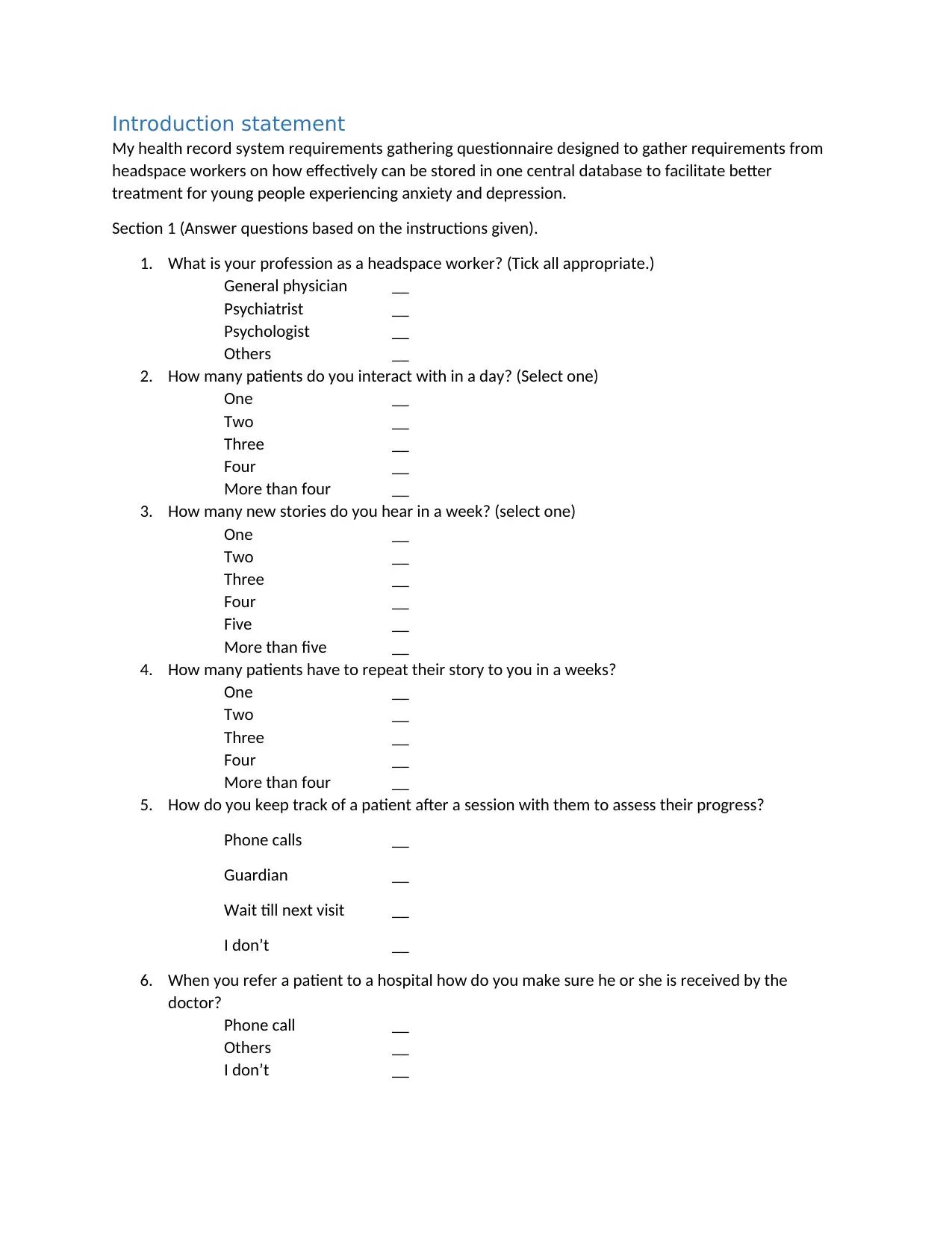
Introduction statement
My health record system requirements gathering questionnaire designed to gather requirements from
headspace workers on how effectively can be stored in one central database to facilitate better
treatment for young people experiencing anxiety and depression.
Section 1 (Answer questions based on the instructions given).
1. What is your profession as a headspace worker? (Tick all appropriate.)
General physician __
Psychiatrist __
Psychologist __
Others __
2. How many patients do you interact with in a day? (Select one)
One __
Two __
Three __
Four __
More than four __
3. How many new stories do you hear in a week? (select one)
One __
Two __
Three __
Four __
Five __
More than five __
4. How many patients have to repeat their story to you in a weeks?
One __
Two __
Three __
Four __
More than four __
5. How do you keep track of a patient after a session with them to assess their progress?
Phone calls __
Guardian __
Wait till next visit __
I don’t __
6. When you refer a patient to a hospital how do you make sure he or she is received by the
doctor?
Phone call __
Others __
I don’t __
My health record system requirements gathering questionnaire designed to gather requirements from
headspace workers on how effectively can be stored in one central database to facilitate better
treatment for young people experiencing anxiety and depression.
Section 1 (Answer questions based on the instructions given).
1. What is your profession as a headspace worker? (Tick all appropriate.)
General physician __
Psychiatrist __
Psychologist __
Others __
2. How many patients do you interact with in a day? (Select one)
One __
Two __
Three __
Four __
More than four __
3. How many new stories do you hear in a week? (select one)
One __
Two __
Three __
Four __
Five __
More than five __
4. How many patients have to repeat their story to you in a weeks?
One __
Two __
Three __
Four __
More than four __
5. How do you keep track of a patient after a session with them to assess their progress?
Phone calls __
Guardian __
Wait till next visit __
I don’t __
6. When you refer a patient to a hospital how do you make sure he or she is received by the
doctor?
Phone call __
Others __
I don’t __
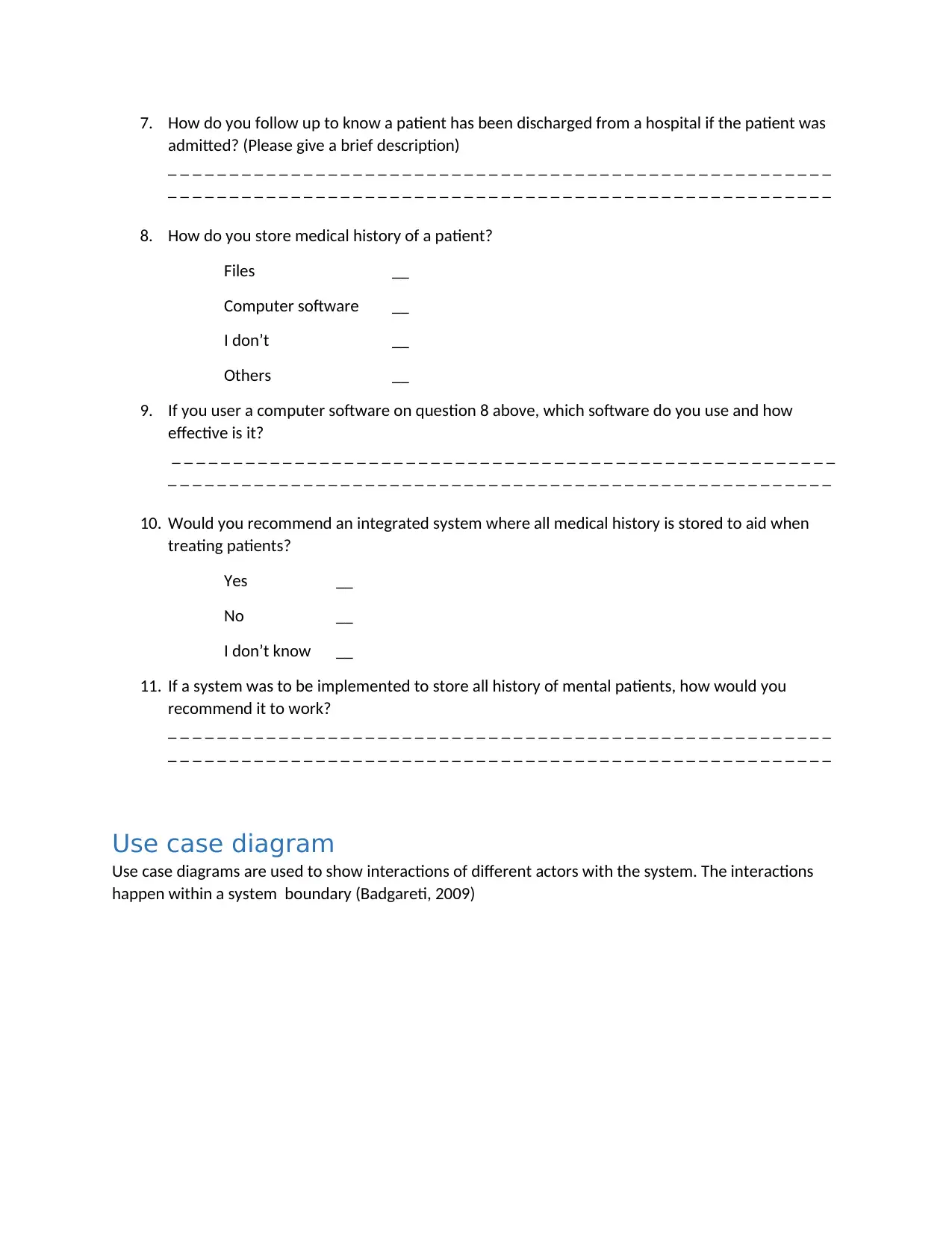
7. How do you follow up to know a patient has been discharged from a hospital if the patient was
admitted? (Please give a brief description)
_ _ _ _ _ _ _ _ _ _ _ _ _ _ _ _ _ _ _ _ _ _ _ _ _ _ _ _ _ _ _ _ _ _ _ _ _ _ _ _ _ _ _ _ _ _ _ _ _ _ _ _ _ _
_ _ _ _ _ _ _ _ _ _ _ _ _ _ _ _ _ _ _ _ _ _ _ _ _ _ _ _ _ _ _ _ _ _ _ _ _ _ _ _ _ _ _ _ _ _ _ _ _ _ _ _ _ _
8. How do you store medical history of a patient?
Files __
Computer software __
I don’t __
Others __
9. If you user a computer software on question 8 above, which software do you use and how
effective is it?
_ _ _ _ _ _ _ _ _ _ _ _ _ _ _ _ _ _ _ _ _ _ _ _ _ _ _ _ _ _ _ _ _ _ _ _ _ _ _ _ _ _ _ _ _ _ _ _ _ _ _ _ _ _
_ _ _ _ _ _ _ _ _ _ _ _ _ _ _ _ _ _ _ _ _ _ _ _ _ _ _ _ _ _ _ _ _ _ _ _ _ _ _ _ _ _ _ _ _ _ _ _ _ _ _ _ _ _
10. Would you recommend an integrated system where all medical history is stored to aid when
treating patients?
Yes __
No __
I don’t know __
11. If a system was to be implemented to store all history of mental patients, how would you
recommend it to work?
_ _ _ _ _ _ _ _ _ _ _ _ _ _ _ _ _ _ _ _ _ _ _ _ _ _ _ _ _ _ _ _ _ _ _ _ _ _ _ _ _ _ _ _ _ _ _ _ _ _ _ _ _ _
_ _ _ _ _ _ _ _ _ _ _ _ _ _ _ _ _ _ _ _ _ _ _ _ _ _ _ _ _ _ _ _ _ _ _ _ _ _ _ _ _ _ _ _ _ _ _ _ _ _ _ _ _ _
Use case diagram
Use case diagrams are used to show interactions of different actors with the system. The interactions
happen within a system boundary (Badgareti, 2009)
admitted? (Please give a brief description)
_ _ _ _ _ _ _ _ _ _ _ _ _ _ _ _ _ _ _ _ _ _ _ _ _ _ _ _ _ _ _ _ _ _ _ _ _ _ _ _ _ _ _ _ _ _ _ _ _ _ _ _ _ _
_ _ _ _ _ _ _ _ _ _ _ _ _ _ _ _ _ _ _ _ _ _ _ _ _ _ _ _ _ _ _ _ _ _ _ _ _ _ _ _ _ _ _ _ _ _ _ _ _ _ _ _ _ _
8. How do you store medical history of a patient?
Files __
Computer software __
I don’t __
Others __
9. If you user a computer software on question 8 above, which software do you use and how
effective is it?
_ _ _ _ _ _ _ _ _ _ _ _ _ _ _ _ _ _ _ _ _ _ _ _ _ _ _ _ _ _ _ _ _ _ _ _ _ _ _ _ _ _ _ _ _ _ _ _ _ _ _ _ _ _
_ _ _ _ _ _ _ _ _ _ _ _ _ _ _ _ _ _ _ _ _ _ _ _ _ _ _ _ _ _ _ _ _ _ _ _ _ _ _ _ _ _ _ _ _ _ _ _ _ _ _ _ _ _
10. Would you recommend an integrated system where all medical history is stored to aid when
treating patients?
Yes __
No __
I don’t know __
11. If a system was to be implemented to store all history of mental patients, how would you
recommend it to work?
_ _ _ _ _ _ _ _ _ _ _ _ _ _ _ _ _ _ _ _ _ _ _ _ _ _ _ _ _ _ _ _ _ _ _ _ _ _ _ _ _ _ _ _ _ _ _ _ _ _ _ _ _ _
_ _ _ _ _ _ _ _ _ _ _ _ _ _ _ _ _ _ _ _ _ _ _ _ _ _ _ _ _ _ _ _ _ _ _ _ _ _ _ _ _ _ _ _ _ _ _ _ _ _ _ _ _ _
Use case diagram
Use case diagrams are used to show interactions of different actors with the system. The interactions
happen within a system boundary (Badgareti, 2009)
⊘ This is a preview!⊘
Do you want full access?
Subscribe today to unlock all pages.

Trusted by 1+ million students worldwide
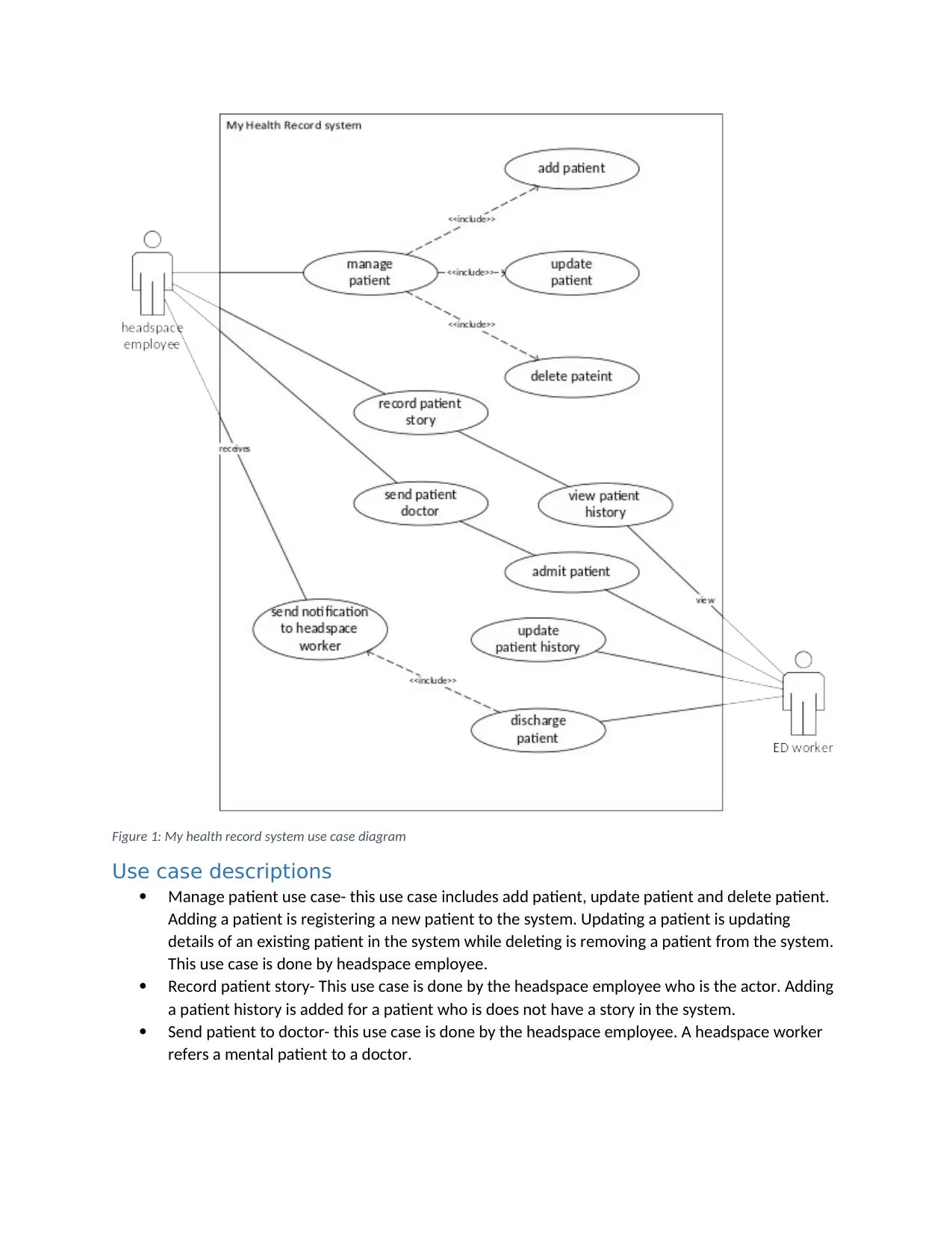
Figure 1: My health record system use case diagram
Use case descriptions
Manage patient use case- this use case includes add patient, update patient and delete patient.
Adding a patient is registering a new patient to the system. Updating a patient is updating
details of an existing patient in the system while deleting is removing a patient from the system.
This use case is done by headspace employee.
Record patient story- This use case is done by the headspace employee who is the actor. Adding
a patient history is added for a patient who is does not have a story in the system.
Send patient to doctor- this use case is done by the headspace employee. A headspace worker
refers a mental patient to a doctor.
Use case descriptions
Manage patient use case- this use case includes add patient, update patient and delete patient.
Adding a patient is registering a new patient to the system. Updating a patient is updating
details of an existing patient in the system while deleting is removing a patient from the system.
This use case is done by headspace employee.
Record patient story- This use case is done by the headspace employee who is the actor. Adding
a patient history is added for a patient who is does not have a story in the system.
Send patient to doctor- this use case is done by the headspace employee. A headspace worker
refers a mental patient to a doctor.
Paraphrase This Document
Need a fresh take? Get an instant paraphrase of this document with our AI Paraphraser

View patient history- an Ed worker views patient history before treating a patient. This is done
to avoid the patient from repeating their story to the ED worker. The ED worker can use the
system to access the history of the patient.
Admit patient- an ED worker admits a patient who is referred by a health space worker. The
admit record is related to the referral record done by the headspace worker.
Update patient history- this is done by a ED worker after treating a patient. The ED worker adds
necessary patient history to the record of the patient.
Discharge patient. An ED worker discharges a patient using this use case. This use case includes
sending a notification to the headspace employee informing the headspace worker that the
patient has been discharged.
Detailed use case description
Use case ID 1
Use case Name Record patient history
Actor Headspace employee
Success scenario 1. Headspace employee opens record story page
2. System displays record story page
3. Headspace employee selects a patient
4. System fetches details of the patients and checks whether
the patient already has a story added to the system
5. System displays add story field.
6. Headspace worker fills the field and presses save.
7. System saves the story under that patient.
Alternative flow 4. System fetches details of the patients and checks whether
the patient already has a story added to the system
4.1 system finds patient already has a story
4.2 System displays the story
References
Badgareti. (2009). Software Engineering – Use Case Diagrams / Descriptions. Computer science source.
Retrieved 2 May 2018, from https://computersciencesource.wordpress.com/2009/11/22/year-
2-software-engineering-use-case-diagrams-descriptions/
McDonald, K. (2017). Stakeholder Map. kbp.media. Retrieved 2 May 2018, from
https://www.kbp.media/stakeholder-map/
Morphy, T. (2015). Stakeholder Mapping Stakeholder Analysis, Project Management, templates and
advice. Stakeholdermap.com. Retrieved 2 May 2018, from
https://www.stakeholdermap.com/stakeholder-analysis.html
to avoid the patient from repeating their story to the ED worker. The ED worker can use the
system to access the history of the patient.
Admit patient- an ED worker admits a patient who is referred by a health space worker. The
admit record is related to the referral record done by the headspace worker.
Update patient history- this is done by a ED worker after treating a patient. The ED worker adds
necessary patient history to the record of the patient.
Discharge patient. An ED worker discharges a patient using this use case. This use case includes
sending a notification to the headspace employee informing the headspace worker that the
patient has been discharged.
Detailed use case description
Use case ID 1
Use case Name Record patient history
Actor Headspace employee
Success scenario 1. Headspace employee opens record story page
2. System displays record story page
3. Headspace employee selects a patient
4. System fetches details of the patients and checks whether
the patient already has a story added to the system
5. System displays add story field.
6. Headspace worker fills the field and presses save.
7. System saves the story under that patient.
Alternative flow 4. System fetches details of the patients and checks whether
the patient already has a story added to the system
4.1 system finds patient already has a story
4.2 System displays the story
References
Badgareti. (2009). Software Engineering – Use Case Diagrams / Descriptions. Computer science source.
Retrieved 2 May 2018, from https://computersciencesource.wordpress.com/2009/11/22/year-
2-software-engineering-use-case-diagrams-descriptions/
McDonald, K. (2017). Stakeholder Map. kbp.media. Retrieved 2 May 2018, from
https://www.kbp.media/stakeholder-map/
Morphy, T. (2015). Stakeholder Mapping Stakeholder Analysis, Project Management, templates and
advice. Stakeholdermap.com. Retrieved 2 May 2018, from
https://www.stakeholdermap.com/stakeholder-analysis.html
1 out of 8
Related Documents
Your All-in-One AI-Powered Toolkit for Academic Success.
+13062052269
info@desklib.com
Available 24*7 on WhatsApp / Email
![[object Object]](/_next/static/media/star-bottom.7253800d.svg)
Unlock your academic potential
Copyright © 2020–2025 A2Z Services. All Rights Reserved. Developed and managed by ZUCOL.





![Stakeholder Map, Questionnaire, and Use Case Project - [Course Name]](/_next/image/?url=https%3A%2F%2Fdesklib.com%2Fmedia%2Fimages%2Fuw%2F8778cb6c6be74a2880d3e3960b21de93.jpg&w=256&q=75)